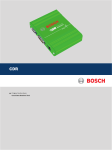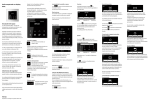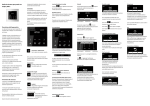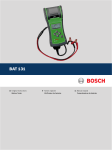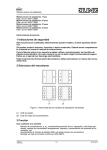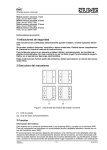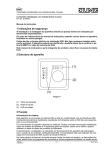Download JUNG R AN LS 914 WW
Transcript
GB Stereo Radio Art.No.:R AN..514.. R AN..914.. ALBRECHT JUNG GMBH & CO. KG Volmestrasse 1 58579 Schalksmühle, Germany [email protected] www.jung.de Safety instructions Caution! Electrical devices may only be installed and fitted by electrically skilled persons. Non-compliance with the installation information could cause damage to the device, fire or other hazards. Danger of electric shock. Before working on the device, disconnect the power or load and switch off the circuit breakers. Danger of electric shock. Loudspeaker connections and power supply may not be wired in one socket. These instructions are a component part of the product and must remain with the end customer. Structure of the device 1 2 7 6 5 4 3 Figure 1: Structure of the radio device 1. 2. 3. 4. 5. 6. 7. Radio Button set Plastic screws Frames Supporting ring with power supply Lever Power supply interface Function Correct use • • Installation in two concealed appliance boxes according to DIN EN 49073 (recommendation: deep boxes). VHF reception in the frequency range 87.5 MHz to 108 MHz Product characteristics • • • • • • • • • • • • • • • Stereo reception Connection terminal for additional external loudspeaker (right stereo channel) Automatic recognition of the second loudspeaker Automatic switching from mono to stereo operation when there is sufficient signal strength and a second loudspeaker is connected Simple operation with additional feedback LED - Blue LED lit up: operational display - Blue LED flashing: Sleep mode active - Red LED lit up: favourite channel High-quality sound and large loudspeaker dynamics Optimised acoustics through the use of a base reflex tube Integrated VHF aerial High reception quality Automatic and manual channel search Non-volatile storage of 4 favourite channels (saved channels remain stored when power supply fails) Switch on with most recent channel and saved volume Sleep mode (switch-off after approx. 30 minutes) Switching on/off possible via extension connection together with the room lighting Switching on/off via potential-free contact A/B (e.g. switch or timer switch with potential-free contact). Operation Switching radio on/off • Press button briefly Device switches on/off. The blue LED lights/switches off iiThe most recently set channel will be called up with the most recently set volume. Sleep mode The radio is switched on. • Press and hold button (approx. 3 seconds). The long press will be acknowledged with a sound. The blue LED flashes. The radio switches off after approx. 30 minutes. Automatic channel search • Press and hold the button's full surface (approx. 3 seconds). The long press will be acknowledged with a sound. The entire frequency range will be scanned and the four strongest channels saved (automatic memory assignment). iiMemory will be overwritten. Manual channel search Searching for channels in ascending/descending frequency. • Press button briefly. The next channel will be selected. Saving/overwriting favourite channel The desired channel frequency is selected. or desired memory button • Press and hold (approx. 3 seconds) , , The saving will be acknowledged with a sound. The channel frequency is saved. iiIf the memory slot is already assigned, it will be overwritten with the frequency of the new channel. Deselecting favourite channel • Briefly press , , or memory button The associated red LED flashes The stored channel will be received. Volume The button sets the volume • Press + button louder • Press - button quieter Information for electrically skilled persons Installation and electrical connection ! Danger! Touching live parts can result in an electric shock. An electric shock can be fatal. Before working on the device, disconnect the power and cover live parts in the area. Installing and connecting radio Installation in two concealed appliance boxes according to DIN EN 49073. In the LS series the installation can also be performed x2 and x3 in surface caps. The installation can be performed either vertically or horizontally. Vertical installation: loudspeaker on top (Fig. 2) left Horizontal installation: loudspeaker on left (Fig. 2) right Figure 2: Vertical and horizontal installation iiFor series A, CD and FD lever (6) position A, for series LS position B (Fig. 1). Additional loudspeaker Series A and CD: An additional loudspeaker must be fitted in a separate frame. LS series: An additional loudspeaker can be fitted in the same frame or a separate one. The cable length may not exceed 10 m. iiLonger cables lead to sound glitches and interference. max. 10 m Figure 3: Additional loudspeaker fitted • • • Power supply connection according to the circuit diagram (Fig. 4). Connection – and + on the radio (Fig. 5) to connect an additional loudspeaker on the right for stereo operation. Use the cable enclosed (l = 1.5 m). Connection A and B on radio (Fig. 5) for connection to a potential-free contact (e.g. switch or timer switch with potential-free contact). • Attach the radio with the frame to the insert. Ensure contact with the power supply. • Fasten radio to the supporting ring (3) with the enclosed plastic screws. Only tighten the plastic screws lightly. • Snap on covers (2). iiThe aerial is integrated. ! Danger! When connecting the loudspeakers or potential-free contact and power supply wires to a shared device socket, the loudspeakers or potentialfree contact cables may come into contact with mains voltage. The safety of the entire radio installation will be endangered. People can also receive an electrical shock at devices that have been disconnected. Lay the loudspeaker or line out cables in separated device sockets in the additional insulation sleeves. L A N 1 B 6 Figure 4: Power supply connection L,N AC 230 V~ connection 1 extension connection - + B A Figure 5: Connection of an external loudspeaker and potential-free contact -/+ External right loudspeaker connection A/B potential-free loudspeaker contact connection Start-up An automatic channel search takes place on the first start-up. The entire frequency range will be scanned and the four strongest channels saved in memory slots 1 to 4. Appendix Technical data Rated voltage: ...........................................................................................AC 230 V ~ Frequency: .................................................................................................... 50/60 Hz Ambient temperature: approx. ..................................................................0 … + 50 °C Relative humidity: ........................................................approx. 15 % … 90 %, no dew Frequency range: .............................................................. 87.50 MHz … 108.00 MHz Protection class: .................................................................................................. IP 20 Separate loudspeaker connection cable ................................Twin loudspeaker cable ...................................................................................................... H03VH-H, 2 x 0.75 ................................................................................ Alternative: JY (st) Y 2x2x0.6 mm Max. length: ......................................................................................................... 10 m Connection:.............................................Screw terminals 1 x 2.5 mm² or 2 x 1.5 mm² Warranty We reserve the right to modify technical and formal characteristics of the product insofar as this supports technical progress. Our products are under guarantee within the scope of the statutory provisions. Please send the device, postage paid, to our central Customer Service Centre, with a description of the error. ALBRECHT JUNG GMBH & CO. KG Service Centre Kupferstr. 17-19 44532 Lünen Germany Telephone: +49 (0) 2355 80 60 Fax: +49 (0) 23 55 . 80 61 89 [email protected] The CE mark is a free trade symbol intended solely for the authorities, and does not carry any guarantee of properties. ALBRECHT JUNG GMBH & CO. KG Volmestrasse 1 58579 Schalksmühle Germany Telephone: +49 (0) 2355 806-0 Fax: +49 (0) 2355 806-189 [email protected] www.jung.de 0024013722 03.2012









